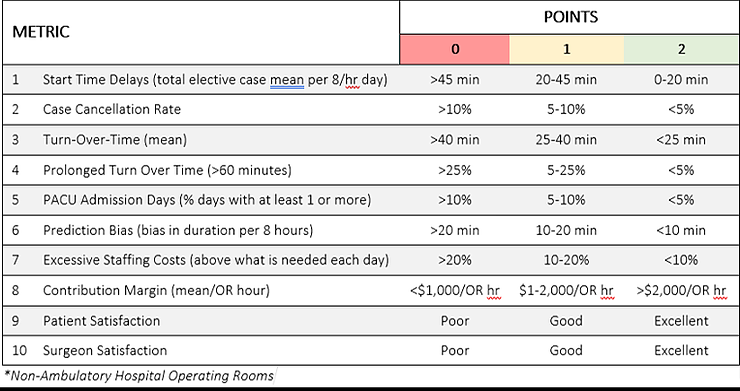A goal of most hospital CEOs today is to drive efficiency in the operating room suite. Often, much of the data needed to draw conclusions regarding OR efficiency is readily available, but not well organized. As a result, little is done from these monthly OR reports leading to no significant changes in OR efficiency.
We’ve created 10 performance indicators for an efficient OR, based on what we hear and experience at facilities. These indicator scores should be followed monthly and discussed in OR committee meetings. Keeping score and tracking improvement will assist in guiding positive changes for your operating rooms.

Given the fact that interpretation is necessary, reviewing these ten performance indicators monthly will start you on the right track to answer the question: “Are my ORs efficient?”
1. On-Time Starts
On-time starts are important not only for efficiency, but also for the morale of the team for that day. Everyone should put forth their best effort to be on time and ready to go. When one team member is late, the whole team slows down and often the momentum for that OR cannot be regained. Incorporating a newer scheduling software can ensure on-time starts by establishing appropriate delays between procedures and keeping start times organized.
2. Case Cancellations
This should be minimized where only new changes in the patient’s medical condition would dictate a cancellation. Today, patients are presenting to surgery with more co-existing disease and complexity than ever before and they must be medically optimized well in advance of elective surgery cases to get a good outcome.
3. Turnover-Time
This should be monitored and evaluated based upon types of surgery rather than averaging across all ORs. When averaged, turn-over-time can be heavily influenced by many short cases that mask the long delays of longer cases. Turn-over-time can also be improved by incorporating artificial-intelligence technology that lets surgeons quickly get data from computer analyzations. Not only does it help shorten the surgery time, it also can reduce medical risks.
4. Prolonged Turnover Time:
Turnover-time should not include situations where cases are intentionally put on hold or if planned gaps of surgery occur by design. Therefore, turnover-times beyond one hour need further scrutiny as to whether a delay is real or planned.
5. PACU Admission Delays
Nursing staff should be scheduled based upon OR volume and expected completion rates of surgery per day. The most expensive PACU costs are created by staying in the OR due to full PACU beds after the surgery is complete or inadequate PACU nursing availability.
6. Prediction Bias
This is often a silent killer to efficiency. Inaccurate posting or tracking of actual case time reduces the efficiency of the OR and leads to under-productivity or may increase the cost for personnel to stay additional hours to complete the case. Getting the right allocation of surgical time needed per surgeon based upon the surgeon’s own history for a specific type of case is essential to keeping the ORs running efficiently.
7. Excessive Staffing Costs
It is great to have an additional pair of hands available when things go wrong, but the fear of the unknown can unjustly increase costs. Operating room management is a dynamic business and changes often. Ideally, staffing should match workload within 10% of the manpower needed to perform the surgery.
8. Contribution Margin per Hour
With surgeons wanting more and more OR time, who gets the open room? The OR is a great resource for income generation and revenue must be considered in the allocation of time. Lower margin cases can often be moved to ambulatory centers where higher productivity counters the lower revenue per case.
9. Patient Satisfaction
In our quest for efficient and cost-effective ORs, we cannot lose sight of our most important customer: our patient. Excellent patient satisfaction must be everyone’s goal and achieving that outcome can be done in an efficient manner. Excellent patient scoring is necessary for hospital rankings. Getting the concept of exceptional patient care and satisfaction accepted by all perioperative providers should be a goal for OR management.
10. Surgeon Satisfaction
The driver for OR volume is the surgeon. The OR managers must appreciate servant leadership in the OR setting to encourage higher productivity from their surgeons. A “can-do” attitude goes a long way toward driving efficiency and productivity. Modernizing the workflow management software your hospital uses can also improve surgeon satisfaction. Newer software allows surgeons to choose which room and equipment they prefer, which can help them to work more efficiently.
